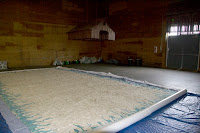UK Tour Day 3- Horniman Museum & Gardens

Karen Dodd’s “Coral:Fabric of the Reef” installation
When I plan my trips, every once in a while I throw in a ‘ringer’ – some place I may have heard obscure reference to, I’m unsure about what I’ll find and decide to try our just for kicks. It’s also good to plan some things which might really appeal to my husband Randy, who’s sweet and tolerent enough to accompany me on my textile exploits.
I read the description of the Horniman Museum and Gardens as a “quirky Victorian collection of artifacts” and thought it sounded like a unique adventure. Not only that, but they also have an aquarium, which appeals to both Randy and myself, having both studied marine biology in our pasts.

The Color Wheel Summer Bedding Garden at the Horniman Museum & Gardens
We arrived a bit before the museum opened, so first toured some of the elaborate gardens, including this “color wheel garden”, which was planted to complement one of their current special exhibitions “Colour: The Rainbow Revealed.”

The original Arts & Crafts style museum
The museum was founded in 1901 by Frederick John Horniman. Frederick had inherited his father’s Horniman’s Tea business, which by 1891 had become the world’s biggest tea trading business. The cash from the business allowed Horniman to indulge his lifelong passion for collecting, and which after travelling extensively had some 30,000 items in his various collections, covering natural history, taxidermied animals and birds, cultural artefacts and musical instruments.

Victorian era natural history exhibitions seek to explain and confirm Darwin’s theory of evolution.
The original museum was designed by Charles Harrison Townsend in the Arts and Crafts style. The collection now exceeds 350,000 objects.
After viewing the gardens, their lovely aquarium, and the interactive colour exhibit (geared towards children), we moved on to the natural history gallery. We were greated by a fabulous sculptural textile collection by artist Karen Dodd.

Pinpoint by Karen Dood
Karen’s work explores the beauty, fragility and vulnerability of coral and coral reefs. Some of the pieces are brightly colored, showing the vibrant interdependent reef life. Other pieces are subdued, representing the destruction of the reef and lifeless coral skeletons.
Karen uses hand-dyed and discharged (colour removal) wool blankets, which are folded, twisted, felted, wrapped & bound, and stitched. The discharging of colour, corresponds to the bleaching of coral in our oceans, as the coral comunities die. She uses fragmentation, shadowing, felting processes, stitching, and holes or gaps to increase the textural nature of each piece, while representing the loss, deterioration, and (hopefully) possibility of regeneration of the coral reef.

Pinpoint, detail

‘Crinkle Return’ by Karen Dodd

‘Crinkle Return’ detail by Karen Dodd

‘A Stitch in Time’ by Karen Dodd

‘A Stitch in Time’ detail by Karen Dodd

‘Lighting the Shadows’ by Karen Dodd
Check out https://www.karen-dodd.com/ Karen’s website to see more in this incredible series!













